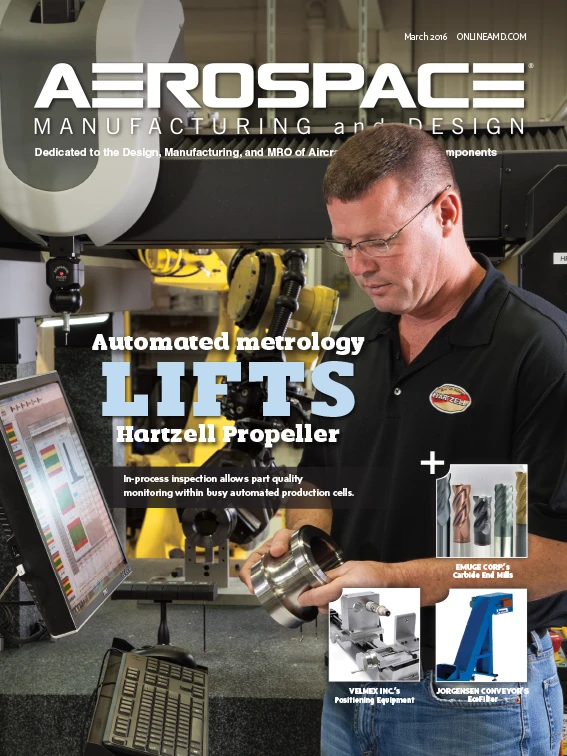
In January, NASA awarded three Commercial Resupply Services (CRS-2) contracts to provide cargo delivery, return, and disposal services for the International Space Station (ISS). The agency selected Orbital ATK of Dulles, Virginia; SpaceX of Hawthorne, California; and Sierra Nevada Corp. (SNC) of Sparks, Nevada. The contracts guarantee a minimum of six cargo resupply missions from each provider through 2024, the end of current funding for the ISS. Although NASA hasn’t ordered any missions yet, discussions and engineering assessments are to lead to integration activities later this year, with resupply flights beginning in late 2019.
Readers of Aerospace Manufacturing and Design’s June 2015 issue may recall that SNC was pursuing development of its Dream Chaser spacecraft despite losing an appeal of NASA’s decision to award commercial crew transportation capability contracts to Boeing and SpaceX. The lessons SNC learned allowed it to adapt its existing vehicle design to compete successfully for NASA’s uncrewed cargo hauling contract.
Modified design
New to the freight-carrying concept is an expendable, pressurized (or unpressurized) cargo module that fits on the rear of the pressurized, lifting-body spacecraft. Once at the ISS, the spacecraft can attach directly to one of the manhole-sized docking ports or maneuver to a berth where astronauts can use a robotic arm to transfer bigger loads through a larger hatch. Before the system’s return to Earth, refuse is loaded into the cargo module to be jettisoned in a fiery reentry, while cargo returning to NASA is placed into the Dream Chaser.

The system’s ability to deliver 5,500kg of pressurized and unpressurized cargo to the ISS exceeds NASA’s requirement to lift 5,000kg.
“Because we can carry so much, it minimizes the number of flights you need to the space station to provide the cargo that the crew and the researchers need. That’s a huge advantage in terms of traffic, crew time, and efficiency of operation to the space station,” says Steve Lindsey, senior director and co-program manager of the Dream Chaser program. Lindsey, a SNC employee for more than four years, served as a test pilot in U.S. Air Force, flew five times aboard the space shuttle with three flights as commander, and was chief of the NASA Astronaut Corps.
Non-toxic return
Unlike the other awardees’ vehicles, the Dream Chaser spacecraft’s low-g reentry and runway landing capabilities will offer the prompt return of sensitive scientific payloads and immediate access to cargo. Speeding access, the Dream Chaser has eliminated the hypergolic fuels and other toxic substances that ground crews for the now-retired space shuttle orbiters had to secure before flight crews could exit and cargo was unloaded.
“The advantage is as soon as we land, a ground crew can come right up to the vehicle, open the hatch, and start unloading that critical cargo,” Lindsey says.
SNC officials are proud that the Dream Chaser’s all non-toxic propellants and consumables will make it the first spacecraft to achieve this environmental benchmark.

“This is a major breakthrough for the space industry while driving long-term environmental responsibility, stewardship, and programmatic sustainability – not to mention that it’s also more affordable,” says Mark Sirangelo, corporate vice president of SNC’s Space Systems. He adds that SNC is working collaboratively with its wholly-owned subsidiary, Orbital Technologies Corp. (ORBITEC), to mature, advance, and refine all of the non-toxic systems being used for the reaction control system (RCS) and environmental control and life support system (ECLSS) on the Dream Chaser spacecraft.
Next steps
The company’s existing atmospheric flight test vehicle – the engineering test article (ETA) – has been upgraded to begin the second phase of flight testing this year, demonstrating orbital flight software that would run the vehicle autonomously. Added instrumentation will gather data about the vehicle’s flight performance. Another former NASA astronaut, Lee “Bru” Archambault, who flew two shuttle missions – one as spacecraft commander – will serve as the Dream Chaser director of flight operations.
Sirangelo says the Dream Chaser Cargo System is designed to be operated autonomously, with ground monitoring.
“In the event of degraded systems, damage, or other issues, we do have ground control operations that exist as a back-up mode. The uncrewed Dream Chaser spacecraft does not require any unique navigational aids, remote systems, or special ground support equipment, beyond GPS signals, and standard navigational aids and systems.”
Next comes building and assembling two orbital flight vehicles. Lockheed Martin in Colorado already has begun building the structure for the first orbital vehicle, and SNC will build cargo modules as customer demand requires. Since the cargo module is disposed of during reentry, a new cargo module is required for every mission.
The group company officials call the Dream Team – SNC and its partner organizations – now spans 25 states and 15 countries and will continue to grow under the CRS-2 contract.
Sierra Nevada Corp. Space Systems
About the author: Eric Brothers is senior editor of Aerospace Manufacturing and Design and can be reached at 216.393.0228 or ebrothers@gie.net.
Get curated news on YOUR industry.
Enter your email to receive our newsletters.

Explore the March 2016 Issue
Check out more from this issue and find your next story to read.
Latest from Aerospace Manufacturing and Design
- Address the challenges of machining high-temperature aerospace components
- Elevate your manufacturing operations with April’s Manufacturing Lunch + Learn
- America Makes announces IMPACT 3.0 Project Call worth $4.5M
- Updated parting and grooving geometries from Sandvik Coromant
- AIX showcases the future of air travel
- Sunnen Products' PGE-6000 gage
- #41 Lunch + Learn Podcast - SMW Autoblok
- Revolutionizing aircraft design without sacrificing sustainability





